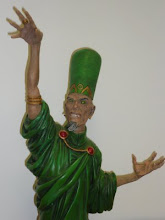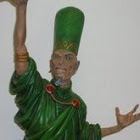
Thursday, 31 December 2009
Silent Scream. Lynda La Plante. Simon & Schuster UK Ltd (2009)

Monday, 28 December 2009
Halfhead. Stuart B. Macbride. HarperVoyager (2009)

Saturday, 26 December 2009
The Mammoth Book of New Sherlock Holmes Adventures. Mike Ashley (Editor) Robinson (2009)

Monday, 21 December 2009
Roseanna. Maj Sjowall & Per Wahloo. Gollancz Crime (1965)

Sunday, 20 December 2009
Borderline. Volume 1. Carlos Trillo (Writer), Eduardo Risso (Art). Dynamite Entertainment (2006)

Saturday, 19 December 2009
The Wrong Man. Alfred Hitchcock. Warner Brothers(1956)

Friday, 18 December 2009
The Willow Pattern. Robert Van Gulik. The University of Chicago Press (1965)

Thursday, 17 December 2009
B.P.R.D. Volume 1. Hollow Earth & Other Stories. Dark Horse Comics (2003)

Sunday, 13 December 2009
Blazing Combat. Fantagraphics Books. (2009)

Friday, 11 December 2009
Blood Money. Chris Collett. Piatkus Books (2007)

Wednesday, 9 December 2009
Cul de Sac. This Exit. Richard Thompson. Andrews McMeel Publishing (2008)

Sunday, 6 December 2009
A Kentish Lad. Frank Muir. Corgi Books (1997)

Wednesday, 2 December 2009
Graveslinger. Shannon Eric Denton & Jeff Mariotte (Writers), John Cboins & Nima Sorat (Art), Chris Wood & Carlos Badilla (Colours). IDW. (2009)

Tuesday, 1 December 2009
The Babes in the Wood. Ruth Rendell. Hutchinson (2002)

Sunday, 29 November 2009
Babette's Feast. Gabriel Axel (Director. MGM (1987)

This film radiates a belief in the possibility of joy and love without ever being false or sentimental. The grim life of the villagers is not glossed over, the petty rivalries of the aging congregation are aired without reducing anyone to caricature. The flashbacks to the younger years of the two daughters where they choose to stay with their father instead of leaving with men who loved them are wonderfully done and do not diminish the daughters.
Saturday, 28 November 2009
Stone Island. Ian Edginton (Writer), Simon Davis (Artist). Rebellion (2008)

Excellent horror comic with a great cast, sharp writing, stunning art and lots of gore being splattered about. Longbarrow Maximum Security Prison, set in a isolated and desolate moorland is where David Sorrell has been sent for the murder of his wife and her lover. Harry Rivers is his cellmate and somewhat mentor in the prison. When one of the inmates mutates into a hideous creature and starts to murder and devour other inmates and guards, Harry reveals his escape plan and he and David flee. They meet up with a few other survivors and find that they are trapped and under siege. The first part comes to an explosive conclusion, the second part takes the survivors and pitches them headlong into a plan to deal with the creatures at source. The action is fast, the cast determined and the story is willing to take a Ian Edginton has written a straightforward horror story with care and craft, the details are sharp and the threats are explicit and forceful. The central element of an isolated group facing an overwhelming threat is nicely managed in both parts, the different context in each case is superbly developed. There is a seam of black humour running through the story that gives the action an additional force and the cast a twist of life as they face their situations. With Sara McCandless, Ian Edginton has created a star, someone you would want at you back when flesh eating creatures are coming in through the window.
Simon Davis' art is stunning, it captures both the gore and the humour, the terrible transformations that some of the cast undergo with great verve, they are both realistic and impossible, just as they should be. The panel layout is dynamic and varied, it gives the story a great pace and allows the lurid colouring space to breathe and exert its influence.
This is a great fun comic, Ian Edginton refers to it a a "gore soaked guilty pleasure", any comic created with this level of care, craft and talent leaves no one with anything to be guilty about the abundant pleasure it provides.
Thursday, 26 November 2009
Ghost in the Shell SAC. Revenge Of The Cold Machines. Junichi Fujisaku. Dark Horse Press (2006)

Monday, 23 November 2009
Hip Flask. Unnatural Selection. Richard Starkings (Writer), Joe Casey (Writer), Landronn (Artist). Active Images (2003)

Sunday, 22 November 2009
Play Dead. Richard Montanari. William Heinemann (2008)

Thursday, 19 November 2009
Tokyo Godfathers. DVD (2003)

Wednesday, 18 November 2009
Not Dead Enough. Peter James. Macmillan (2007)

Monday, 16 November 2009
Ancient Rome. The Rise and Fall of an Empire. Simon Baker. BBC Books (2007)

Wednesday, 11 November 2009
The Best of H.T. Webster. A Memorial Collection. Simon and Schuster (1953)

Sunday, 8 November 2009
Ghost In The Shell. Shirow Masamune. Dark Horse Manga (2004)

A great collection of stories revolving around an anti-terrorist public security team in a future Japan where the boundaries between human and machine are becoming blurred due to advances in prosthetics. Public Security Section 9 is lead by Major Motoko Kusanagi who has a fully artificial body, her spine and brain are the only biological elements, the rest of the team are more or less equipped with mechanical upgrades. They operate in an information drenched society where a cyberbrain in required to provide access to the net and allow normal functioning. This naturally gives new opportunities to criminals an terrorists to infiltrate individuals and attack the "Ghost in the Shell", the human personality of the individual. The stories are nicely varied, they mix up the political landscape of the future state of Japan with straightforward criminal activities. The final episodes raise interesting questions about what would happen if a machine intelligence became self aware.
This is a really dense comic, the art is crowed with detail and the stories are packed with ideas and explanations as well. Shirow Masamue manages to use this density to enhance the momentum of the stories, to place his cast in a credible context and to bring them to vivid and sharply defined life. The art is wonderfully easy to read and skillfully uses changing styles to move the mood of the story. Major Motoko is a great character, vibrantly human in her artificial body.
Ghost in the Shell is smart, funny and thoughtful science fiction, in a word, brilliant.
Saturday, 7 November 2009
Spider. Michael Morley. Penguin Books (2008)

Monday, 2 November 2009
The Saga of Solomon Kane. Dark Horse Books (2009)

Friday, 30 October 2009
Famous Players. Rick Geary ( Writer & Art). NBM Comics (2009)

Thursday, 29 October 2009
Millennium. Tom Holland. Abacus (2009)

In one of the greatest practical jokes in history modern Europe was born because the end of the world failed to arrive when it was expected. The Christian world expected that the world would end and the Day of Judgement arrive in the at the first Millennium, one thousand years after the birth or death of Jesus Christ. The enormous social, political and religious forces this expectation released collided, combined and confronted each other to create the foundations of Western Europe as we have it today. Tom Holland has written a hugely entertaining book that shows how and why the process took place. It is a fantastic story and it is told with outstanding skill, with an enormous cast of vivid characters and a geographical range from London to Kiev, Tom Holland's talent for clarity and comprehensiveness never falters.
The prospect of the end of the world crystallised a number of forces that combined and confronted each other. On one hand there was the growth in empire building and the emergence of new ruling elites. This activity was savagely brutal and bloody. The new ruling elites wanted to be granted legitimate status and the source of this was the Christian Church. The Church was concerned with the violence of the emerging rulers while at the same time realising that they were the vanguard of the spread of Christianity, a very necessary project in the light of the upcoming divine day of judgement. The Church, as much as the secular rulers, had new elites emerge in the drive to develop an Christian empire and the confrontations between these forces is at the heart of the book.
The huge energy dedicated to getting the world in order for an event that never arrived created significant forces that had the time and energy to continue shaping the world in whatever way they saw fit. The momentum of the millennium carried them on to creating the extraordinary developments that saw Europe emerge as the political, religious and technological global leader in defiance of any prospects prior to the millennium. This exhilarating book is sweeping narrative history that shows how the present is never far from our past. Unmissable.
Saturday, 24 October 2009
Blind Eye. Stuart Macbride. HarperCollinsPublishers. (2009)

Friday, 23 October 2009
Mercy. J.M.DeMatteis (Writer), Paul Johnson (Art), Todd Klien (Letters). DC Comics (1993)

Tuesday, 20 October 2009
Bruno Chief of Police. Martin Walker. Quercus. (2009)

Monday, 19 October 2009
John Stuart Mill. Victorian Firebrand. Richard Reeves. Atlantic Books (2007)

Sunday, 18 October 2009
Team of Rivals. Doris Kearns Goodwin. Penguin Books (2009)

Saturday, 17 October 2009
Orion. Shirow Masamune (Writer & artist). Dark Horse Magna (2008)

Thursday, 15 October 2009
Fer-De-Lance (1934), The League of Frightened Men (1935). Rex Stout. Bantam Books. (2008)

Sunday, 11 October 2009
Just a Pilgrim. Garth Ennis (Writer), Carlos Ezquerra (Artist), Paul Mounts, Ken Wolak (Colours), Chris Eliopoulos (Letters). Dynamite (2008)

Saturday, 10 October 2009
The Riverman. Alex Gray. Sphere (2007)

Friday, 9 October 2009
Defoe 1666. Pat Mills (Writer), Leigh Gallagher (Art), Ellie De Ville (Letters). Rebellion (2009)

Wednesday, 7 October 2009
Appleseed. Geneon Entertainment (2004) DVD

Monday, 5 October 2009
Between The Lines. Janis Ian. CBS (1975)

The songs in this collection are drenched in this struggle between the hope for fulfillment and the sharp reality of living and the compromises that it entails. "At Seventeen" is the most explicit accounting of the divergence between reality and the dreams and the price that is extracted for having them in the first place. "Bright Lights and Promises" looks at what a life is like when the dreams you had are all you have to cling to as you move through a life you could never have imagined, a life that is based on simulating romance.
Tuesday, 29 September 2009
Hunter's Moon. David Devereux. Gollancz (2007)


